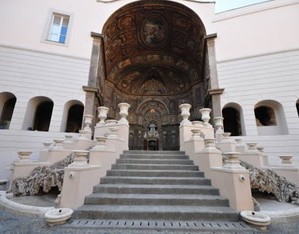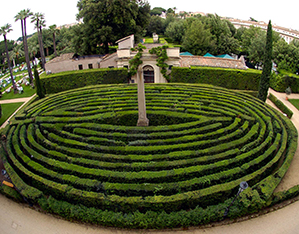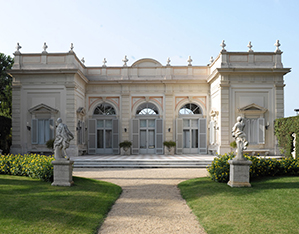A seat of power throughout the centuries, the Quirinale has been Papal residence, royal palace during the Savoy monarchy, and today seat of Italy’s Presidency. Many world leaders have walked along the paths of its beautifully tended gardens adorned with spectacular fountains.
Since the 15th century the Quirinal Hill had been loved by refined humanists who used its small gardens for their literary banquets. Due to its central location in the city and its healthy fresh air, since the 16th century the Quirinal Hill was considered an ideal pleasure-palace location by many powerful cardinals, including Ippolito d’Este (the owner of Villa d’Este in Tivoli). Later it also became the summer seat of the Papacy. With its towers and high walls, the complex encloses one of the most highly praised gardens of that period, laid out in different areas, each with a different view of the city, with wooden structures forming galleries and domes lined with plants so that guests could take a stroll in the fresh shade. The formal gardens were laid out with blooming flowerbeds – with many valuable bulbous plants in the 17th century – and with a rich decor of ancient sculptures, of which only a part have survived. There was also a thicket with a large variety of trees and a rock fountain with a mosaic flooring and water features. The surrounding walls were covered with espaliers of citrus fruit and pomegranates. Each Pope left a sign of his personal taste, with the help of important architects and sculptors, creating a stratified complex which nonetheless remained based on the 16th-century structure, even though many fountains mentioned in the historical records are no longer in place. It was only at the end of the 19th century, with the arrival of the Savoy royal family, that the symmetries of the paths and flowerbeds were substituted by a more open and articulated layout, following the picturesque style that had become popular, even if belatedly, in Italy.
Highlights

The Fontana dell’Organo
Built by order of Clemence VIII and completed in 1596, the Fountain of the Organ is a large niche reached by the three flights of steps that fan out, built taking advantage of the sloping surface of the hill. The walls and the vault are decorated with polychrome stucco and mosaics depicting the Stories of Moses and the Creation. The fountain contains a recently-restored hydraulic organ and on either side of it there are two rooms that were used as fresh and cool spaces to find refuge during the hot summer season. One of the rooms is a reproduction of Vulcan’s smithy and can be seen from the overhead terrace.

The Maze
At the side of the palazzo there is a small oval-shaped boxwood maze dating back to Pope Gregory XVI (1831-1846) with a small obelisk the centre and cypress trees at the entrance. A good view of its structure can be enjoyed from terrace above the Casina Svizzera, a small 19th century rustic construction.

The Coffee house
During Benedetto XIV’s papacy, in 1741 architect Ferdinando Fuga built an elegant pavilion anticipating Neoclassic architecture. The three-arched loggia is flanked by two protruding spaces richly decorated with views of Rome and evangelical scenes. The wide openings of the loggia allowed people to enjoy the garden even in winter. The back of the building offers a beautiful view of the city.
 Giardini del Quirinale
Contacts
Giardini del Quirinale
Contacts
Contacts
Telephone:+39 06 39967557 (Call center prenotazioni)
Address
Via del Quirinale all’altezza di Via della Consulta
00187, Roma (RM)
 Giardini del Quirinale
Opening times and prices
Giardini del Quirinale
Opening times and prices
Opening hours
VISITS TO THE QUIRINALE PALACE AND OTHER SITES ARE TEMPORARILY SUSPENDED
Timetable
- from 9:30 a.m. to 4:00 p.m.
- last entrance for route 1 (artistic-institutional) at 2.30 p.m.
- for route 2 (artistic-institutional and thematic) 1.30 p.m.
You must arrive 15 minutes before the start of the visit.
Opening days
- Tuesday – Wednesday – Friday – Saturday – Sunday.
- The Palace will be closed: 8 March, 21 April, 1 May, from 23 May to 3 June, from 29 July to 2 September, from 23 December to 6 January 2020.
Booked visits may be subject to change due to institutional commitments. In this case it will be possible to make the visit on another date or obtain a refund of the amount paid.
Pricing
Access to the Quirinal Palace and Gardens is by reservation only, indicating the route chosen for the visit:
- Route 1 (artistic-institutional): visit to the Piano Nobile and the Ground Floor – average duration h. 1:20’.
- Route 2 (artistic-institutional and thematic): which includes in addition to route 1 the visit to the Vasella, the Gardens and the Carriages – total average duration h. 2:30’.
Costs
- Route 1 is free, except for the compulsory reservation of € 1.50.
- Route 2 has a cost of € 10, including the booking service. It is free of charge for the students and teachers of the schools organising the visits; for those under 18 years of age; for students and teachers of the Faculties of Architecture, Conservation of Cultural Heritage, Educational Sciences and the Faculties of Literature or Literary subjects, with an archaeological or historical-artistic focus, of the Faculties of Literature and Philosophy and of the Fine Arts Academies, on presentation of the certificate of enrolment for the current academic year; for the disabled and their companions, subject to booking fees.
- For visitors aged between 18 and 25 and over 65, and for state school teachers, the cost of route 2 is €5.
Reservation is required at least 5 days before the visit. For further information please consult the website.
 Giardini del Quirinale
How to get there
Giardini del Quirinale
How to get there
Address
Via del Quirinale all’altezza di Via della Consulta
00187, Roma (RM)
Latitude: 41.901772
Longitude: 12.487799
How to arrive by road
The Quirinale Palace is located within the restricted traffic zone. It is advisable to reach the Palace using public transport.
How to arrive by train
Roma Termini Station: from Piazza dei Cinquecento take Line 40 (P.za Pia/Castel S. Angelo) for 2 stops and get off at Nazionale/Quirinale. Walk 100 meters to the Quirinale Palace and reach the entrance on Via del Quirinale (height Via della Consulta).
How to arrive by bus
Bus number: 40-60-64-70-117-170-H. Get off at Nazionale/Quirinale stop
Additional directions
By subway
- metro A (stop P.za della Repubblica)
- metro B (Cavour stop)
From Fiumicino Airport of Fiumicino
- Take the LeonardoExpress train to Termini (departure every 30 min.) Get off at Termini and go to the TERMINI stop (MA-MB-FS) take line 40 (P.Za Pia/Castel S. Angelo) for 2 stops and get off at Nazionale/Quirinale. Walk for 100 meters to Piazza del Quirinale and reach the entrance on Via del Quirinale (height Via della Consulta).
 Giardini del Quirinale
Services/Accessibility
Giardini del Quirinale
Services/Accessibility
Accessibility
Motor disability
- In order to allow for adequate assistance, it is advisable to indicate at the time of booking the visit any impediments or limitations resulting from a disability condition.
- During the tour it is possible to use lifts and other means to overcome architectural barriers.
- For the crossing of the gardens there could be problems in moving with prams and pushchairs, given the presence of gravel.
Blind and visually impaired
- There are currently no tactile paths available for the blind and visually impaired.
 Giardini del Quirinale
Private events
Giardini del Quirinale
Private events
 Giardini del Quirinale
Itineraries
Giardini del Quirinale
Itineraries
You could find the garden in these itineraries
 Favorite saving result
Favorite saving result
 Warning!
Warning!
You've have to sign up or sign in to add this element to your favorites.
